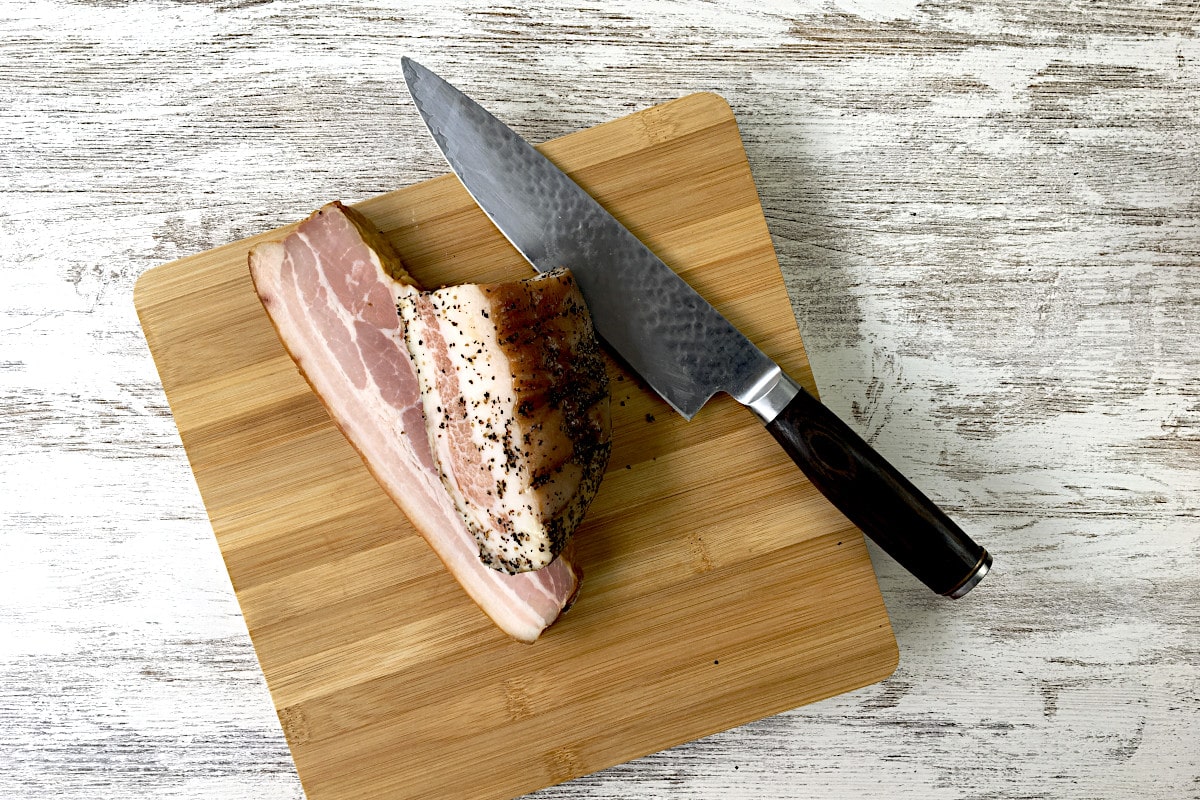

The History of Spaghetti Carbonara
So let us talk about Spaghetti Carbonara, one of the most famous pasta dishes from Italy. Just buy some pasta, put it to a boil, mix it with ham or bacon, add some cream, if you want some green peas and garlic, and mix everything. Done! No? Well, you can do that, but only if you want to offend an Italian. You also can make just your kind of pasta, which is perfect, but you definitely can’t call it a classic Spaghetti Carbonara then.
The original and classic Spaghetti Carbonara just consists of a few simple ingredients and the whole dish is quick and straightforward. The classic ingredients are spaghetti, guanciale (cured pork jowl) or pancetta, pecorino, eggs, and black pepper.
As with many dishes, the origins and the history are never completely clear and there exist many variations of the story. Everybody has to choose his favorite one to believe in until somebody can prove the complete truth.
Although Spaghetti Carbonara is famous from the region of Lazio and Rome, one of the versions about the origin says, that the pasta descends from the Napolitanian pasta cacio e uova, which is made with melted lard, eggs, and cheese. This quite similar pasta was first documented in Ippolito Cavalcanti’s Neapolitan cookbook from 1839.
Another story connects the origin of this pasta to the charcoal burners (Carbonari in Roman dialect) in the mountainous L’Aquila area who prepared it using ingredients that are easily available and stored.
The most supported version though connects the origin of Spaghetti Carbonara with the period after the liberation of Rome in 1944 by the allied troops. When Rome was liberated, the food shortage was extreme, and one of the few resources was military rations, distributed by the allied troops; these included eggs (in powder) and bacon making the beginning for this famous dish.

The simple secret about Spaghetti Carbonara
Besides using the right ingredients, there are just a few simple details when preparing Spaghetti Carbonara. First of all, you have to know how to cook pasta properly, but more about that later.
To make the perfect creamy Spaghetti Carbonara you have to understand how to mix the eggs into the pasta without making scrambled eggs, and you will see, that there is really no need for any cream. The key to success is to add the eggs at the correct time, which should be done once the pan is off the heat while mixing steadily and continuously.
When you strain the pasta it is important that you keep some of the cooking water to add to the mixture later in the procedure. The cooking water is full of dissolved starches which naturally act as an emulsifier and glue to stick the sauce to the noodles. On the other side also helps you to moderate the consistency of your sauce.

Guanciale or Bacon?
If available, you should definitely buy guanciale or pancetta instead of bacon. If you only can get bacon, then try to get not smoked bacon. And in my opinion, but do not tell anybody, also smoked bacon makes great Spaghetti Carbonara because I personally like the smoky flavor. But just that you know, the different meats will make a big difference in taste and smoked bacon is not the right piece when making classic Spaghetti Carbonara.
All three are cured pork meats with a high percentage of fat. While pancetta and bacon are both from the pork belly, guanciale is from the jowl.
Guanciale is salted for a few days in sea salt. After that, the meat is brushed to remove the salt, and some additional spices and ground black pepper are added. The aging is about 60-70 days in a temperature and humidity-controlled areas.
Pancetta is cured with salt and several other spices and then dried for a period of three months after which it is ready for consumption.
Bacon on the other hand is not only cured but is also smoked through what is known as a cold-smoking process without any cooking.

Pecorino or Parmesan for Spaghetti Carbonara?
Because classic Spaghetti Carbonara originates from the region of Lazio and Rome, the natural choice of cheese is Pecorino Romano. Some Italians that come from the northern regions of Italy may use Parmesan cheese. In my recipe, I go for half Pecorino and half Parmesan, but you can take the cheese to your liking.
Pecorino simply means “from sheep” in Italian, and there exist about six different varieties in Italy, but the best known is the Pecorino Romano, a hard, cured, and salty sheep cheese.
The history of pecorino goes back to ancient Rome where its long-life capacity and high nutritional value made it a staple food supply for the Roman army. Although the name may lead to the region of Lazio and Rome, nowadays just a very small percentage of Pecorino Romano is produced in this region. The legislation gives Pecorino Romano the designation of origin, but it allows the production in Sardinia which is the largest producer of this classic cheese.
Maybe the most famous cheese from Italy, Parmesan on the other hand is a cheese made from raw cow milk and much less salty than Pecorino. To be called Parmigiano Reggiano, the cheese can only be produced in the Emilia Romagna region and has a lot of specific rules of production.
If you like Parmesan, try this sweet recipe – baked cheesecake

How to cook pasta?
To make Carbonara the most used sort of Pasta, are Spaghetti or Rigatoni. If you use Spaghetti, try to use a thicker type like Spaghettoni.
Cooking Noodles seems to be one of the easiest tasks in the kitchen, but there is still a lot of confusion about it.
If Pasta is served as a main dish, you normally count about 100g – 125g of dry pasta per person. The result after cooking will be double in weight (about 200g – 250g).
For each liter of water, you should use about 10g of salt. This may seem like a lot of salt but is important to get flavor into the pasta. There is some discussion on whether to add salt to the water before or after the water boils, but in reality, the difference will not be notable. But if you put a lid on the pot until the water boils, it will certainly make a difference in boiling time and energy needed.
There is no need to add any kind of oil to the cooking water because it is scientifically impossible that the oil gets in contact with the noodles, and will only swim like a film on the water surface. So keep that oil for later in the process. Do not forget to stir the noodles in the water about one minute after you added the pasta, so it will not stick together.
When the cooking time is over, and you are going to strain the pasta, never pass your noodles with cold water, except you want to make a cold noodle salad. This is because you are washing away the starch that comes out of the noodles during the cooking process and naturally helps you, that the sauce sticks to the pasta. So if you want that the noodles bind perfectly with your sauce, just never wash those noodles. Maybe you might think if you don’t pass cold water the noodles will stick to each other. Well, that’s the point where you should add your olive oil and incorporate it.

Classic Spaghetti Carbonara Recipe
Equipment
- cheese grater
Ingredients
- 250 g spaghetti
- 200 g guanciale or pancetta
- 2 eggs
- 1 egg yolk
- 50 g pecorino cheese
- 50 g parmesan cheese
- fresh ground black pepper
Instructions
- Cut the guanciale or pancetta in cubes or stripes, but not too small.
- Put the cut guanciale/pancetta in a cold pan and turn to medium heat, so the fat renders out slowly. It is really important that this process is not made on high heat, to get the guanciale/pancetta nice and crispy.
- Grate de 120g of Cheese (60g pecorino/60g parmesan) and mix with 3 eggs and 1 egg yolk. Add some fresh ground black pepper and beat together with a whisk or a fork until homogenous.
- Add salt to the water (more or less 10g/liter) for the spaghetti and bring to a boil with a lid on. Cook until al dente. When you strain the noodles, keep 1/2 liter of the cooking water.
- When the noodles are cooked turn off the heat of the frying pan with the guanciale/pancetta and add the noodles. Toss the noodles to coat them in the fat of the guanciale/pancetta.
- Verify again that the heat is turned off before you go to the next step and let cool slightly.
- Add the egg and cheese mixture to the pan and mix vigorously until incorporated. The egg and cheese mixture together with the starch of the noodles and the fat of the guanciale will form a creamy sauce and emulsify everything. If you want the sauce a little more smooth or liquid you just add some of the pasta cooking water until the consistency is to your liking.
- Season with some more black pepper and serve.

















